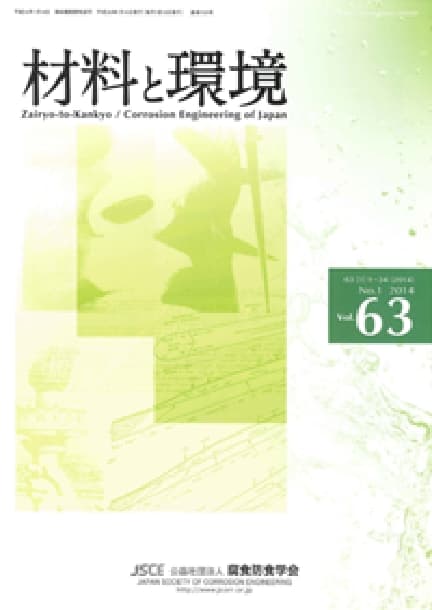- TOP
- Zairyo-to-Kankyo
- Vol. 72 (2023), No. 11
Zairyo-to-Kankyo Vol. 72 (2023), No. 11
Backnumber
-
Vol. 74 (2025)
-
Vol. 73 (2024)
-
Vol. 72 (2023)
-
Vol. 71 (2022)
-
Vol. 70 (2021)
-
Vol. 69 (2020)
-
Vol. 68 (2019)
-
Vol. 67 (2018)
-
Vol. 66 (2017)
-
Vol. 65 (2016)
-
Vol. 64 (2015)
-
Vol. 63 (2014)
-
Vol. 62 (2013)
-
Vol. 61 (2012)
-
Vol. 60 (2011)
-
Vol. 59 (2010)
-
Vol. 58 (2009)
-
Vol. 57 (2008)
-
Vol. 56 (2007)
-
Vol. 55 (2006)
-
Vol. 54 (2005)
-
Vol. 53 (2004)
-
Vol. 52 (2003)
-
Vol. 51 (2002)
-
Vol. 50 (2001)
-
Vol. 49 (2000)
-
Vol. 48 (1999)
-
Vol. 47 (1998)
-
Vol. 46 (1997)
-
Vol. 45 (1996)
-
Vol. 44 (1995)
-
Vol. 43 (1994)
-
Vol. 42 (1993)
-
Vol. 41 (1992)
-
Vol. 40 (1991)
Keyword Ranking
17 Dec. (Last 30 Days)
Zairyo-to-Kankyo Vol. 72 (2023), No. 11
Rust Preventive oil
Naoki Nagase
pp. 278-283
DOI:
10.3323/jcorr.72.278Abstract
Rust preventive oil is used for relatively short periods of time, such as during storage and transportation during the manufacture of metal parts. It is one of the rust prevention means used for the purpose of temporary rust prevention for a period of time.
Readers Who Read This Article Also Read
Zairyo-to-Kankyo Vol.72(2023), No.11
Zairyo-to-Kankyo Vol.72(2023), No.10
Effect of Dissolved 90Sr and 137Cs in HCl Solutions on the Corrosion Potential of Type 316L Stainless Steel
Takahito Aoyama, Tomonori Sato, Fumiyoshi Ueno, Chiaki Kato, Naruto Sano, Naoki Yamashita, Takahiro Igarashi
pp. 284-288
DOI:
10.3323/jcorr.72.284Abstract
In order to analyze the effect of beta particles in solution on the corrosion of Type 316L stainless steel, the effect of dissolved 90Sr on the corrosion potential was investigated. 90Sr standard solution and 137Cs standard solution were dropped into HCl while the corrosion potential was measured in HCl. As a result, the potential increase in the solution with 90Sr standard solution was larger than that in the solution with 137Cs standard solution. The results were verified by calculations, which show that the difference in the rate of formation of H2O2 in solution due to water radiolysis causes a difference in the change in potential in both solutions.
Readers Who Read This Article Also Read
Zairyo-to-Kankyo Vol.72(2023), No.11
Zairyo-to-Kankyo Vol.72(2023), No.10
Corrosion Evaluation of WAKUGI made of Newly Developed Iron used for Preservation Repair of the Cultural Assets Building
Masamitsu Matsumoto, Akito Sakoda, Masahiro Suehiro, Takayuki Nishi, Hiroko Watanabe, Shougo Honkyuu
pp. 289-298
DOI:
10.3323/jcorr.72.289Abstract
The purpose is to inherit the technical properties of the past as much as possible to manufacture Japanese nails, Wakugi, used for preservation and repair of Japanese wooden buildings. Therefore, we investigated the technical properties of Wakugi from the Azuchi-Momoyama period to the Edo period, when Tatara ironmaking reaches maturity, from the viewpoints of chemical composition, surface film structure, and corrosion resistance. Prevention of iron stain on wood and long-term corrosion resistance were evaluated by electrochemical measurements and accelerated corrosion tests on Wakugi made by hot forging by handmade work by blacksmiths.
Article Access Ranking
17 Dec. (Last 30 Days)
-
Delayed Fracture Mechanism of 1700 MPa-Class Quenched and Tempered Bolt under Atmospheric Corrosion Environment
Tetsu-to-Hagané Advance Publication
-
Perspectives on the Promising Pathways to Zero Carbon Emissions in the Steel Industry toward 2050
ISIJ International Vol.65(2025), No.2
-
Effect of B on Surface Oxidation Behavior and Phosphatability of Si-Mn-added Cold-Rolled Steel Sheets
ISIJ International Advance Publication
-
Factors Influencing the Bonding Phase Structure of Iron Ore Sinters
ISIJ International Vol.43(2003), No.9
-
Effect of microstructural heterogeneity on fatigue limit of as-quenched low-carbon low-alloy martensitic steel
ISIJ International Advance Publication
-
Prussian blue as a fully reversible hydrogenochromic material for visualizing hydrogen distribution in Fe sheet
ISIJ International Advance Publication
-
Metallurgical Aspects on Interstitial Free Sheet Steel From Industrial Viewpoints
ISIJ International Vol.34(1994), No.1
-
Microstructures and Reduction Properties of High CaO Concentration Sintered Ore
ISIJ International Advance Publication
-
Influence of Antimony on the Oxidation Characteristics of 65Mn Steel
ISIJ International Advance Publication
-
From plasticity to fracture in pearlitic microstructures: Atomistic study of cementite thickness and deformation localization
ISIJ International Advance Publication
You can use this feature after you logged into the site.
Please click the button below.










